王治奎《大学英汉翻译教程》【笔记课后习题及翻译示例汇总考研真题详解】(文学翻译)
王治奎《大学英汉翻译教程》【笔记课后习题及翻译示例汇总】(日常应用文的翻译)【圣才出品】

第12章日常应用文的翻译12.1 复习笔记一、社交信件的翻译英文书信一般由信头(Heading)、信内地址(Inside Address)、称呼(Salutation)、正文(Body)、结束语(Complimentary Closing)、签名(Signature)六部分组成。
有时还有附言(Postscript)、附件(Enclosure)等。
社交信件种类很多,根据其不同作用和用途,可分为馈赠信、答谢信、祝贺信、慰问信、吊唁信、道歉信和邀请信(或请柬)等。
1. 馈赠信用词简练。
语气诚恳。
译时,应注意选用简洁热情的汉语词句。
并译出写信人的诚意。
2. 慰问信语言简练,措辞中肯。
感情真挚。
译时应选用语气贴切的汉语词句,译出写信人的同情心和分担忧伤的好意。
3. 祝贺信祝贺喜庆,字里行间充满热烈、喜悦的感情。
译时,应用欢快的汉语词句,译出写信人真挚、喜悦的心情。
4. 道歉信诚恳、坦率、客气,但不过分谦卑。
译时。
应用恰当的汉语词句组织译文。
译出写信人坦诚的歉意。
5. 吊唁信用词简朴。
语气低沉。
感情真挚。
译时,应慎重措辞,不能因措辞不当而引起收信人的过度悲伤。
6. 答谢信内容单一,只表谢意,一般陈述答谢的理由,以显示并非虚情假意。
要译出写信人真挚的谢意。
7. 翻译正式请柬应选用庄重、严谨的汉语词句组织译文,可套用汉语传统的请柬习语与程式。
例:为欢迎马塔·兰小姐,罗杰·B·克拉克博士及夫人,谨定于9月20日(星期四)8时于派克大街250号举行宴会,敬请弗兰克·诺斯先生及夫人光临。
回柬一般按收到的请柬格式行文,可参照请柬的翻译要求处理。
二、事务应用文的翻译(一) 事务书信事务信件措辞更严谨,语气更庄重。
翻译事务性书信,可适当套用汉语相应书信和公函的常用习语,表达原文的意思。
1. 推荐信推荐信是向个人或单位推荐某个自己熟悉的入而写的信件,一般措辞精练、语气中肯、叙事客观。
写给单位的推荐信,其称呼常用“To Whom It May Concern”,意思是“致有关人士”,可套用汉语书函用语,将其译成“敬启者”或“台鉴”等。
王文轲老师考研翻译课12组翻译译文

翻译课12组翻译译文G r o u p O n e:C l a u s e1.商业人士认为,更加难以证实的是他们主持着的生产力革命是否真实存在。
2.审计员完全有理由相信,那些有明确目标而且知道如何实习那目标的科学家没有必要分心走神:一边关注点钞机,一边还要关注显微镜。
3.我发现,放弃“忙碌应对生活”的信念而选择“低调生活”这种做法所带来的回报要比经济上的成功和社会地位的提高更大;凯尔西长期经受巨大的压力,因而辞去了《她》杂志主编的职务——这一举动受到公众的广泛关注,她终将发现这一点。
4.这种着眼于顾客的方法就是人们所知的营销观念,这种营销观念其简单之意就是:制造商和经销商并不是试图出售最容易生产或转售的产品,而是首先尽力发现顾客想购买的商品,然后着手生产这些商品以便顾客购买。
5.一名包装学专家解释说,他可以通过把粗糖装进漂亮的罐中,或是使一个装五盎司的瓶子看上去可以装八盎司的东西,就可以使粗糖的价格涨二点五倍,即从一美元涨到二点五美元时,他实际上是在告诉公众,包装可能是一种非常费钱的奢侈品。
6.还有解释说,正是由于我们本能地对人类十分了解,所以没有科学地研究这些直觉的动力:对于一些明显的事,人们为什么要建立一种理论,再进行系统地观察或是作一些预言呢?7.“苹果是落到地面而不是落向树上”这一事实回答了他过去一直在问自己的问题——有关天空中那些更大的果实(月亮和行星)的问题。
8.由于越来越多的证据表明红色行星上曾经含有大量稳定的液态水,由于人们对细菌化石是火星上的一块陨石带到地球上的这种观念争议不休,因此,有关该行星上是否曾经存在生命以及生命是否持续到今天的争论更加激烈。
9.生产商通过改变包装大小以减少罐头所装产品的数量从而提高产品的单价,这样他可以不费吹灰之力将其产品装入盒子、袋子和罐头中,这些盒子、袋子和罐头可以装四盎司、八盎司、一磅以及两磅质量的早餐食品、混合好了的蛋糕等。
10.并且用于培训工人的有限投资也只是片面地用于培训做下一项工作所需的特殊技能,而不是用于培训能够吸收新技术的基本技能。
王治奎《大学英汉翻译教程》【笔记课后习题及翻译示例汇总考研真题详解】(科技英语的翻译)

第17章科技英语的翻译17.1 复习笔记一、词汇特点及汉译(一) 专业术语翻译英语中的专业词汇一般可分为两类:(1) 源于希腊语和拉丁语的专业词汇,有些词国际通用,一般说来概念单一,汉译时不难处理。
(2) 借自日常用语的普通词汇,这些词的一个显著特点是一词多用、一词多义。
汉译时,应根据所译材料的不同专业领域和不同的上下文,选择适合该领域及上下文的正确、规范的词义。
(二) 非专业词汇的翻译常采用的译法有如下几种:1. 引申把一些不便直译的具体化名称,根据其字面意思加以引申。
例:Electric power became the servant of man only after the motor was invented.只是在电动机发明之后,电力才开始造福人类。
2. 具体化将表达具体事理的字面意思抽象和笼统的词语译成意义具体、含义明确的汉译词语。
例:The pupil of the eye responds to the change of light intensity.瞳孔可以随着光线强弱的变化放大或缩小。
3. 省略本着科技作品简练的原则,汉译时,有时将原文中的一些动词、名词或表示同一事物的不同的重复用词加以省略。
例:Stainless steels possess good hardness and high strength.不锈钢硬度大,强度高。
4. 新词的翻译翻译新词时,应认真分析其各个组成部分的含义,运用构词法知识,必要时请教专业技术人员,确定其词义。
例:A visicorder is provided to record current and voltage waveforms.[译文]可显示记录器用来记录电流和电压波形。
[分析]visicorder是一种仪表,从构词法角度看,该词是由visible(可见的)和recorder(记录器)两词缩合而成,故将其译成“可显示记录器”。
《大学汉英翻译教程》 第三章 词语的英译与常用技巧

• … because of their glamorous looks and affected manners, were universally known by the nickname of Darling and Precious. (David Hawkes译)
• 文中的“香怜”和“玉爱”这两个名字的蕴含 意义在原文语言环境下尤为重要,因此杨宪益 夫妇和Hawkes都选择放弃音译,而是根据其 内含的文化,用地道的英文昵称来将其译出, 更能体现出原文展现的文化风格。
• ③这部美剧很有意思。
• This American TV series is very interesting. • 这句中的“意思”的指称意义是“有趣,趣
味”,因而用“interesting”。 • ④我们快走吧,天有点要下雨的意思。
• Let’s hurry up. It is likely to rain soon. • 本句中的“意思”则是指“某种趋势或迹象”,
• 3.2.3 根据语言语境消除歧义
• 我们来看徐迟的《哥德马赫猜想》中的这样一段对话: • “你们算了!”老师笑着说,“算了!算了!” • “我们算了!我们算了,我们算出来了!” • “你们算啦,好啦好啦,我是说你们算了吧,白费这个力气做什么?你
们这些卷子我是看看不会看的,用不着看,那么容易吗?”
this vain attempt? I won’t check your papers, because there is no need. Don’t you think this is that easy?”
王治奎《大学英汉翻译教程》【笔记课后习题及翻译示例汇总】(翻译的性质、标准及要求)【圣才出品】
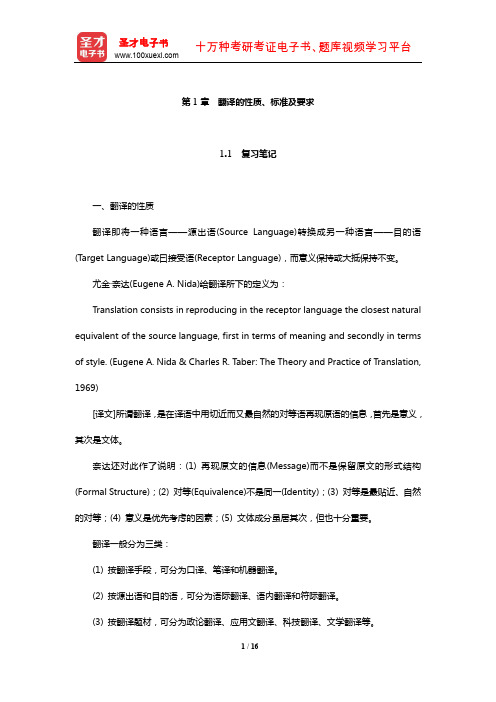
第1章翻译的性质、标准及要求1.1 复习笔记一、翻译的性质翻译即将一种语言——源出语(Source Language)转换成另一种语言——目的语(Target Language)或曰接受语(Receptor Language),而意义保持或大抵保持不变。
尤金·奈达(Eugene A. Nida)给翻译所下的定义为:Translation consists in reproducing in the receptor language the closest natural equivalent of the source language, first in terms of meaning and secondly in terms of style. (Eugene A. Nida & Charles R. Taber: The Theory and Practice of Translation, 1969)[译文]所谓翻译,是在译语中用切近而又最自然的对等语再现原语的信息,首先是意义,其次是文体。
奈达还对此作了说明:(1) 再现原文的信息(Message)而不是保留原文的形式结构(Formal Structure);(2) 对等(Equivalence)不是同一(Identity);(3) 对等是最贴近、自然的对等;(4) 意义是优先考虑的因素;(5) 文体成分虽居其次,但也十分重要。
翻译一般分为三类:(1) 按翻译手段,可分为口译、笔译和机器翻译。
(2) 按源出语和目的语,可分为语际翻译、语内翻译和符际翻译。
(3) 按翻译题材,可分为政论翻译、应用文翻译、科技翻译、文学翻译等。
二、翻译的标准翻译标准,亦曰翻译原则,即指导翻译实践、评价译文质量的尺度。
(一) 泰特勒的三原则与严复的三字标准1. 亚历山大·F·泰特勒(Alexander Fraser Tytler)在《论翻译的原则》中提出了三条基本原则:(1) A translation should give a complete transcript of the ideas of the original work.(译文应完全复写出原作的思想。
王治奎《大学英汉翻译教程》【笔记课后习题及翻译示例汇总考研真题详解】(慎于修辞)

第7章慎于修辞7.1 复习笔记翻译修辞是贯彻翻译标准,确保译文忠实、通顺的主要手段。
翻译修辞的几点要求如下:一、译文明确无误是翻译修辞的首要要求二、“文字意同而立语自有工拙”翻译必须讲究“语工”。
Histories make men wise; poets witty; the mathematics subtle; natural philosophy deep; moral grave; logic and rhetoric able to contend. (Francis Bacon) 读史使人明智,读诗使人灵秀,数学使人周密,科学使人深刻,伦理使人庄重,逻辑修辞使人善辩。
三、“简洁乃智慧之灵魂”No admittance for passengers.旅客止步。
四、叙述层次要分明五、译文要文从字顺。
承上启下。
流畅自然六、选词要适当,用词要得体这里主要指翻译要考虑原文的文体特征、作者的风格特征,以及所涉及的人物(如文学作品)的性格、年龄、受教育程度、社会地位等特征。
Tourism for Development旅游促进发展(广告用语)七、适当运用汉语的四宇词组在翻译中成功地运用四字词组,可以使译文生动、形象、有力。
八、尽量保留原文的修辞方法,或灵活利用译入语的修辞方法,以增强译文的力量或效果1. 重复(1) 保留原有句法结构的重复Energy imports and consumptions must be reduced, competition enhanced by rigid enforcement of pertinent laws, and general monetary growth retained.能源的进口和消耗必须减少,竞争必须通过相关法律的严格实施来加强,货币的总增长必须限制。
(2) 利用同义词或近似同义词进行重复What John said made his wife stare with mouth open.约翰的话使他的妻子张口结舌,目瞪口呆。
英汉翻译基础教程考试重点总结
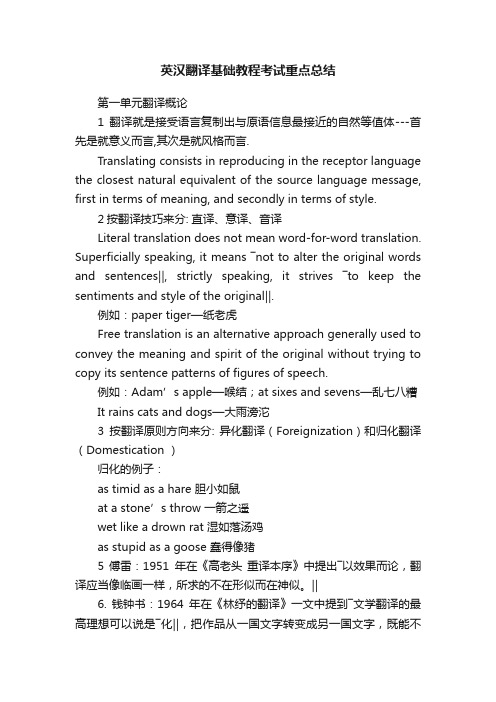
英汉翻译基础教程考试重点总结第一单元翻译概论1翻译就是接受语言复制出与原语信息最接近的自然等值体---首先是就意义而言,其次是就风格而言.Translating consists in reproducing in the receptor language the closest natural equivalent of the source language message, first in terms of meaning, and secondly in terms of style.2按翻译技巧来分: 直译、意译、音译Literal translation does not mean word-for-word translation. Superficially speaking, it means ―not to alter the original words and sentences‖, strictly speaking, it strives ―to keep the sentiments and style of the original‖.例如:paper tiger—纸老虎Free translation is an alternative approach generally used to convey the meaning and spirit of the original without trying to copy its sentence patterns of figures of speech.例如:Adam’s apple—喉结;at sixes and sevens—乱七八糟It rains cats and dogs—大雨滂沱3按翻译原则方向来分: 异化翻译(Foreignization)和归化翻译(Domestication )归化的例子:as timid as a hare 胆小如鼠at a stone’s throw 一箭之遥wet like a drown rat 湿如落汤鸡as stupid as a goose 蠢得像猪5 傅雷:1951年在《高老头重译本序》中提出―以效果而论,翻译应当像临画一样,所求的不在形似而在神似。
王治奎《大学英汉翻译教程》【笔记课后习题及翻译示例汇总考研真题详解】(辩证施治)
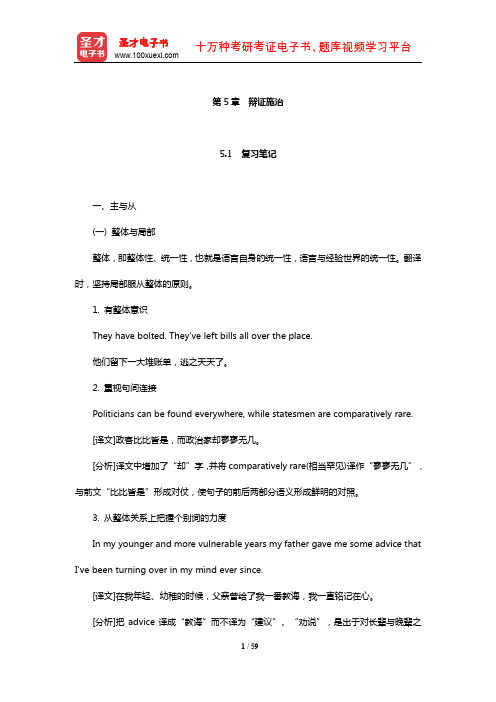
第5章辩证施治5.1 复习笔记一、主与从(一) 整体与局部整体,即整体性、统一性,也就是语言自身的统一性,语言与经验世界的统一性。
翻译时,坚持局部服从整体的原则。
1. 有整体意识They have bolted. They've left bills all over the place.他们留下一大堆账单,逃之天天了。
2. 重视句间连接Politicians can be found everywhere, while statesmen are comparatively rare.[译文]政客比比皆是,而政治家却寥寥无几。
[分析]译文中增加了“却”字,并将comparatively rare(相当罕见)译作“寥寥无几”,与前文“比比皆是”形成对仗,使句子的前后两部分语义形成鲜明的对照。
3. 从整体关系上把握个别词的力度In my younger and more vulnerable years my father gave me some advice that I've been turning over in my mind ever since.[译文]在我年轻、幼稚的时候,父亲曾给了我一番教诲,我一直铭记在心。
[分析]把advice译成“教诲”而不译为“建议”、“劝说”,是出于对长辈与晚辈之间关系的考虑。
(二) 主要信息与次要信息英语和汉语都基本上遵守“先轻后重,先次要后重要”的原则。
但也有许多例外。
1. 用加字法或改换说法,突出主要信息I do not in that period remember his ever saying a complimentary word to me.据我的记忆,他在那个时期没有夸奖过我一句。
2. 将次要信息并入主要信息。
After the latest round of talks, they were still unable to agree on a number of points.最新一轮会谈仍未使他们在某些问题上取得一致意见。
王治奎《大学英汉翻译教程》【笔记课后习题及翻译示例汇总考研真题详解】(广告英语的翻译)

第14章广告英语的翻译14.1 复习笔记一、英语广告的语言特点及汉译(一) 用词和语法结构特点及汉译处理1. 言简意赅,句式简洁英语广告中大量使用缩略词和简短通俗的各式动词,多用省略句、祈使句、破折句和独词句,不用或少用冗长的复合句。
2. 使用大众化口语体主要表现在大量使用口语词、俚语和人称代词,尤其是第二人称代词,以增加语言的可读性和亲切感。
3. 大量使用褒扬溢美之词广告,特别是情感诉求类广告,语言生动,文笔从容,具有很强的感召力。
翻译时,应选用生动活泼的汉语词句组织译文,以保持原文的语气和风格。
(二) 修辞特点及翻译要求1. 模拟生造词语When your taste grows up, Winston out-tastes them all.当你的鉴赏能力提高以后,你会发现温斯顿牌香烟味道最佳。
2. 对句Small deposit,Big return. (银行广告)小额存款,巨额收益。
3. 对偶Moisture,It keeps a flower fresh and beautiful all day.Moisture Wear Powder,It keeps your skin fresh and beautiful all day.雨露——保持鲜花艳美,雨露护肤粉——保持肌肤艳美。
4. 双关语We take a load off your mind. (航运公司广告)本公司货运质量可靠,客户无须烦恼。
5. 排比6. 借用谚语Where there is a way for car there is a Toyota. (仿照where there is a way there is a will. )车到山前必有路,有路必有丰田车。
二、英语广告的文体特点及翻译要求(一) 普通广告文体1. 陈述体陈述体广告讲求用事实说话,开门见山地介绍商品名称、用途、功效等情况,语言质朴,行文端庄。
翻译时应选用平实的汉语,以严肃客观的语气组织译文。
王治奎《大学英汉翻译教程》【笔记课后习题及翻译示例汇总】(翻译的过程)【圣才出品】

第2章翻译的过程2.1 复习笔记翻译过程包括两个阶段:正确理解(Accurate Comprehension)和充分表达(Adequate Representation)。
前者是后者的前提,后者是前者的结果,两者是有机的统一。
一、正确理解正确理解是正确认识和把握原文的思想内容、感情和风格等的过程。
整个理解过程是双向的:(1) 从整体到局部;(2) 从局部到整体。
即先进行宏观分析,再进行微观研究,微观和宏观相结合。
二、如何实现正确理解(一) 语义分析语义分析(Semantic Analysis)是语言分析的一个分支,说明处在一定语境中、按照一定次序排列的词项之间的语义关系,探索词项的意义。
语义分析的注意事项:1. 注意词的概念意义(Conceptual Meaning)和关联意义(Associative Meaning)。
例:(1) seat oneself in a wooden chair坐在木椅里(chair的本义,即概念意义)(2) accept a university chair同意在大学里执教(关联意义)(3) chair the board meeting主持董事会(关联意义)(4) condemned to the chair被处电刑(关联意义)2. 把握意义关系(Sense Relations),特别注意同义与反义、褒义与贬义、多义与歧义等关系。
例:(1) He has the reputation of being a blood-sucker.他是个臭名昭著的吸血鬼。
(2) She has made a reputation for herself through hard work.她勤奋工作为自己赢得了声誉。
3. 了解文化特性、历史演变、社会发展和技术进步对语言的影响。
例:“Greek and Latin are all English to me,” said Oscar Wilde.[译文]“希腊语和拉丁语对我来说都很容易,”奥斯卡·王尔德说。
王治奎《大学英汉翻译教程》【综合练习及详解】【圣才出品】

附录综合练习及详解说明:该附录全面收录《大学英汉翻译教程》(第4版)(王治奎主编)中的综合练习1和综合练习2,每篇短文后面不仅有参考译文,而且还有列举出相应的翻译要点及解析,对于以该书为教材的考生来说,具有极高的参考价值和较强的指导性,同时可以帮助考生巩固该书所学内容。
综合练习1及详解1Four score①and seven years ago our fathers brought forth on this continent a new nation, conceived in Liberty, and dedicated to the proposition that all men are created equal.Now we are engaged in a great civil war testing whether that nation or any nation so conceived and so dedicated, can long endure. We are met on a great battlefield of that war. We have come to dedicate a portion of that field as a final resting place for those who here gave their lives that that nation might live. It is altogether fitting and proper that we should do this②.But, in a larger sense, we can not dedicate—we can not consecrate—we can not hallow—this ground. The brave men, living and dead, who struggled here, have consecrated it, far above our poor power to add or detract. The world will little note, nor long remember what we say here, but it can never forget③what they did here.It is for us the living, rather, to be dedicated here to the unfinished work which they who fought here have thus far so nobly advanced. It is rather for us to be here dedicated to the great task remaining before us—that from these honored dead we take increased devotion to that cause for which they gave the last full measure of devotion—that we here highly resolve that these dead shall not have died in vain—that this nation, under God, shall have a new birth of freedom—and that government of the people, by the people, for the people, shall not perish from the earth④.(From Living Documents of American History)【参考译文】87①年前,我们的先辈在这个大陆上建立了一个以自由为理想,以人人平等为宗旨的新国家。
王治奎《大学英汉翻译教程》综合练习及详解【圣才出品】
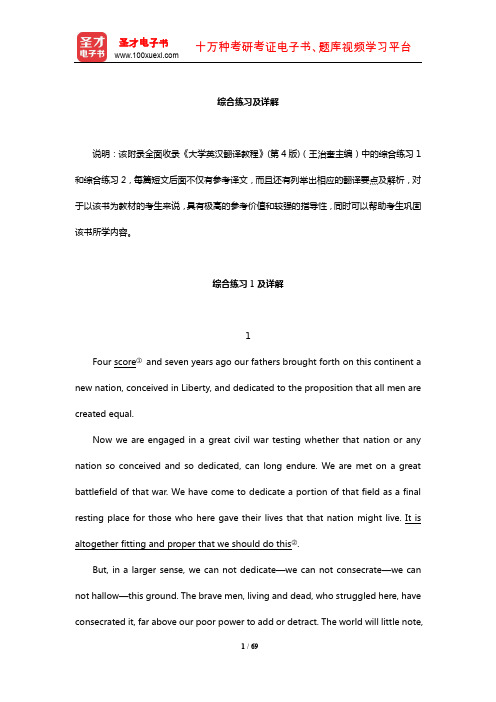
综合练习及详解说明:该附录全面收录《大学英汉翻译教程》(第4版)(王治奎主编)中的综合练习1和综合练习2,每篇短文后面不仅有参考译文,而且还有列举出相应的翻译要点及解析,对于以该书为教材的考生来说,具有极高的参考价值和较强的指导性,同时可以帮助考生巩固该书所学内容。
综合练习1及详解1Four score①and seven years ago our fathers brought forth on this continent a new nation, conceived in Liberty, and dedicated to the proposition that all men are created equal.Now we are engaged in a great civil war testing whether that nation or any nation so conceived and so dedicated, can long endure. We are met on a great battlefield of that war. We have come to dedicate a portion of that field as a final resting place for those who here gave their lives that that nation might live. It is altogether fitting and proper that we should do this②.But, in a larger sense, we can not dedicate—we can not consecrate—we can not hallow—this ground. The brave men, living and dead, who struggled here, have consecrated it, far above our poor power to add or detract. The world will little note,nor long remember what we say here, but it can never forget③what they did here. It is for us the living, rather, to be dedicated here to the unfinished work which they who fought here have thus far so nobly advanced. It is rather for us to be here dedicated to the great task remaining before us—that from these honored dead we take increased devotion to that cause for which they gave the last full measure of devotion—that we here highly resolve that these dead shall not have died in vain—that this nation, under God, shall have a new birth of freedom—and that government of the people, by the people, for the people, shall not perish from the earth④.(From Living Documents of American History)【参考译文】87①年前,我们的先辈在这个大陆上建立了一个以自由为理想,以人人平等为宗旨的新国家。
新编大学英译汉教程-绪论
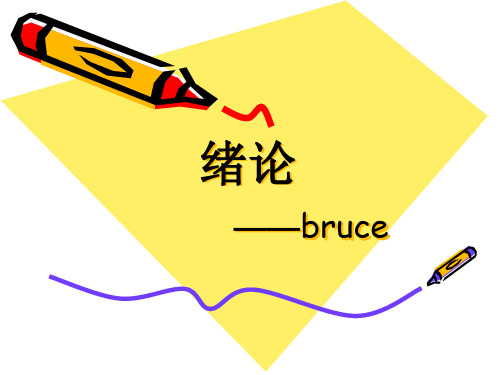
从理解的角度改进下列英语句子的汉语 译文
(1)I will teach him to deceive others. 原译:我要教他去欺骗别人。
改译:我要教训他一顿,看他还敢不敢再欺骗人。
(2)This thesis leaves much to be desired. 原译:这篇文章有很多地方让人喜欢。
怎样才能成为合格的者
1、译者要打下扎实的英语基础(要掌握足够 的词汇量,要掌握系统的英语语法知识,要 大量阅读英语原著); 2、译者要打下扎实的汉语基础,特别是提高 自己的汉语表达能力(要大量阅读汉语原著, 进行汉语写作训练); 3、广博的文化知识(know sonething aout everything;know everything about something); 4、掌握常用的翻译策略(增、减、分、合、 转等); 5、要养成认真负责、谦虚谨慎的态度;
第二,要正确处理内容与形式的关系。 He is one of the 8 children. 译一:他是8个孩子中的一个. 译二:他有7个兄弟姐妹。
The cold weather frosted up the track last night. 译一:昨晚寒冷的天气使跑道上结了霜。 译二:昨晚天气寒冷,跑道上结了霜。 得”意“忘”形
张培基把翻译的标准概括为“忠实(既指译文忠实于原文 的内容,不得有任何的篡改、歪曲、遗漏或任意删减,又 指译文应保持原作的风格。)”、“通顺(指译文语言必 须流畅,符合译入语的规范。)”四个字。(适用于学生)
翻译的过程
1、理解
理解是翻译的第一步,也是翻译全过程中最重要的一步;
至少阅读原文三遍:第一遍粗读原文,掌握原文大意,对 一些疑难词句作上记号;第二遍细读原文,逐词、逐句、 逐段地仔细研究,解决疑难问题;第三遍通读原文,以便 “见树见林”,将全文精神“融汇于心”;
翻译材料(本科)
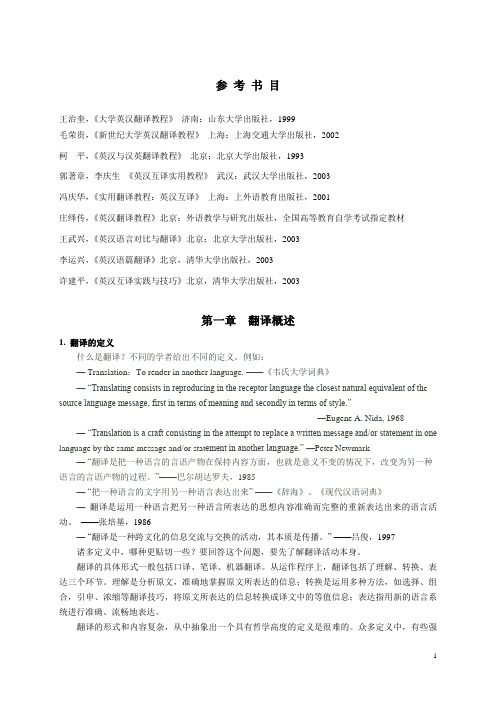
参考书目王治奎,《大学英汉翻译教程》济南:山东大学出版社,1999毛荣贵,《新世纪大学英汉翻译教程》上海:上海交通大学出版社,2002柯平,《英汉与汉英翻译教程》北京:北京大学出版社,1993郭著章,李庆生《英汉互译实用教程》武汉:武汉大学出版社,2003冯庆华,《实用翻译教程:英汉互译》上海:上外语教育出版社,2001庄绎传,《英汉翻译教程》北京:外语教学与研究出版社,全国高等教育自学考试指定教材王武兴,《英汉语言对比与翻译》北京:北京大学出版社,2003李运兴,《英汉语篇翻译》北京,清华大学出版社,2003许建平,《英汉互译实践与技巧》北京,清华大学出版社,2003第一章翻译概述1. 翻译的定义什么是翻译?不同的学者给出不同的定义。
例如:— Translation:To render in another language. ——《韦氏大学词典》—“Translating consists in reproducing in the receptor language the closest natural equivalent of th e source language message, first in terms of meaning and secondly in terms of style.”—Eugene A. Nida, 1968 —“Translation is a craft consisting in the attempt to replace a written message and/or statement in one language by the same message and/or stat ement in another language.” —Peter Newmark —“翻译是把一种语言的言语产物在保持内容方面,也就是意义不变的情况下,改变为另一种语言的言语产物的过程。
王治奎《大学英汉翻译教程》【笔记课后习题翻译示例汇总】-第1~4章【圣才出品】
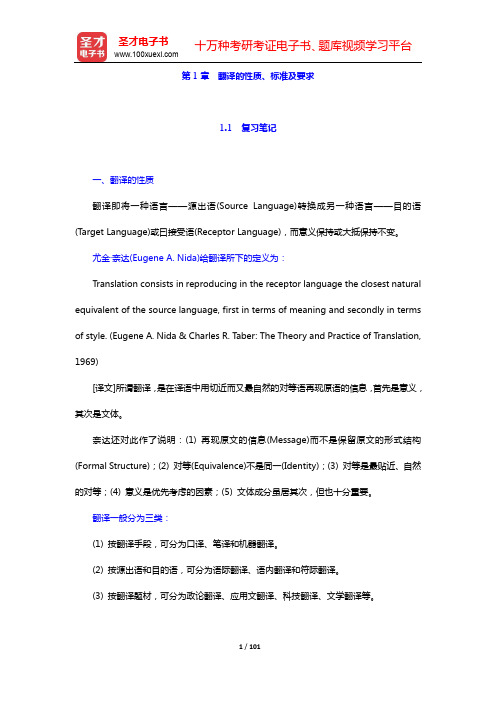
第1章翻译的性质、标准及要求1.1 复习笔记一、翻译的性质翻译即将一种语言——源出语(Source Language)转换成另一种语言——目的语(Target Language)或曰接受语(Receptor Language),而意义保持或大抵保持不变。
尤金·奈达(Eugene A. Nida)给翻译所下的定义为:Translation consists in reproducing in the receptor language the closest natural equivalent of the source language, first in terms of meaning and secondly in terms of style. (Eugene A. Nida & Charles R. Taber: The Theory and Practice of Translation, 1969)[译文]所谓翻译,是在译语中用切近而又最自然的对等语再现原语的信息,首先是意义,其次是文体。
奈达还对此作了说明:(1) 再现原文的信息(Message)而不是保留原文的形式结构(Formal Structure);(2) 对等(Equivalence)不是同一(Identity);(3) 对等是最贴近、自然的对等;(4) 意义是优先考虑的因素;(5) 文体成分虽居其次,但也十分重要。
翻译一般分为三类:(1) 按翻译手段,可分为口译、笔译和机器翻译。
(2) 按源出语和目的语,可分为语际翻译、语内翻译和符际翻译。
(3) 按翻译题材,可分为政论翻译、应用文翻译、科技翻译、文学翻译等。
二、翻译的标准翻译标准,亦曰翻译原则,即指导翻译实践、评价译文质量的尺度。
(一) 泰特勒的三原则与严复的三字标准1. 亚历山大·F·泰特勒(Alexander Fraser Tytler)在《论翻译的原则》中提出了三条基本原则:(1) A translation should give a complete transcript of the ideas of the original work.(译文应完全复写出原作的思想。
王治奎《大学英汉翻译教程》【笔记课后习题及翻译示例汇总考研真题详解】(旅游英语的翻译)

第15章旅游英语的翻译15.1 复习笔记一、旅游英语的文体特点旅游英语是一种应用英语,形式多样,有旅游指南、旅游日程安排、旅游广告、旅游条件书等。
下面我们以旅游指南为重点,探讨旅游英语的一般语言特点。
(一) 涉猎面广,词汇量大旅游是一门综合性的活动,因此旅游英语词汇量极大。
(二) 生动形象,引人入胜1. 描写细腻,文字优美2. 幽默风趣,活泼有效3. 富有哲理,发人深省(三) 活泼热情,富有感染力二、旅游英语的翻译(一) 文化因素的处理旅游翻译是一种跨文化、跨心理的交流工作。
翻译时,须尽力避免死译、硬译,并灵活处理所涉及的文化信息。
1. “洋化”采取“洋化”译法,以保持异域特色。
Venice is the Shakespeare of cities—unchallenged, incomparable, and beyond envy.威尼斯是城市中的莎士比亚——举世称赞,无与伦比,令人诚服。
2. 增减翻译过程中需对某些轻描淡写的费解词语做注释性说明。
The United States was founded chiefly by WASPs who originally came from across the Atlantic Ocean.美国主要是来自大西洋彼岸的盎格鲁—撒克逊白人新教徒——简称WASP——建立的。
3. 改写为了更好地向游客传达文化信息,常常以游客熟悉或易于接受的方式翻译。
Venice is the 'Queen' of the Adriatic Sea.威尼斯是亚得里亚海之王。
(二) 应注意的问题1. 语言差异英语重形合,汉语重意合,英语重物称(Impersonal),汉语重人称(Personal);英语多被动(Passive),汉语多主动(Active)。
翻译时必须充分考虑两者的不同表达习惯。
2. 思维方式差异思维方式和表达方法是相互影响的。
因此,在充分考虑语言差异的同时,应研究分析思想方式的异同。
《大学汉英翻译教程》中的“译例”问题评析-文档资料
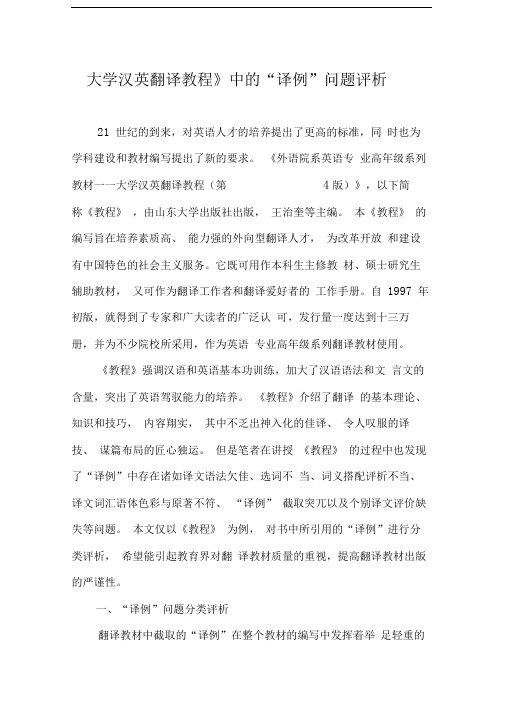
大学汉英翻译教程》中的“译例”问题评析21 世纪的到来,对英语人才的培养提出了更高的标准,同时也为学科建设和教材编写提出了新的要求。
《外语院系英语专业高年级系列教材一一大学汉英翻译教程(第4版)》,以下简称《教程》,由山东大学出版社出版,王治奎等主编。
本《教程》的编写旨在培养素质高、能力强的外向型翻译人才,为改革开放和建设有中国特色的社会主义服务。
它既可用作本科生主修教材、硕士研究生辅助教材,又可作为翻译工作者和翻译爱好者的工作手册。
自1997 年初版,就得到了专家和广大读者的广泛认可,发行量一度达到十三万册,并为不少院校所采用,作为英语专业高年级系列翻译教材使用。
《教程》强调汉语和英语基本功训练,加大了汉语语法和文言文的含量,突出了英语驾驭能力的培养。
《教程》介绍了翻译的基本理论、知识和技巧,内容翔实,其中不乏出神入化的佳译、令人叹服的译技、谋篇布局的匠心独运。
但是笔者在讲授《教程》的过程中也发现了“译例”中存在诸如译文语法欠佳、选词不当、词义搭配评析不当、译文词汇语体色彩与原著不符、“译例” 截取突兀以及个别译文评价缺失等问题。
本文仅以《教程》为例,对书中所引用的“译例”进行分类评析,希望能引起教育界对翻译教材质量的重视,提高翻译教材出版的严谨性。
一、“译例”问题分类评析翻译教材中截取的“译例”在整个教材的编写中发挥着举足轻重的作用。
只有通过恰当的“译例”传递,才能帮助学生在翻译实践中理解翻译理论,并自觉把所学的翻译理论及技巧在自己的翻译实践中加以运用。
因此,选择高质量的“译例”及译文应该引起翻译教材编写者的足够重视。
本部分将从以下四个层面对《教程》的“译例”问题分类评析。
1.语法与选词层面评析(1)助之长着,揠苗者也。
(《孟子》)They who assist itto grow long pull out their corn shoots. (Tr. JamesLegge )此“译例”有两处错误,一是译文语法欠佳,另一个是译文用词不精当。
王治奎-大学汉英翻译教程
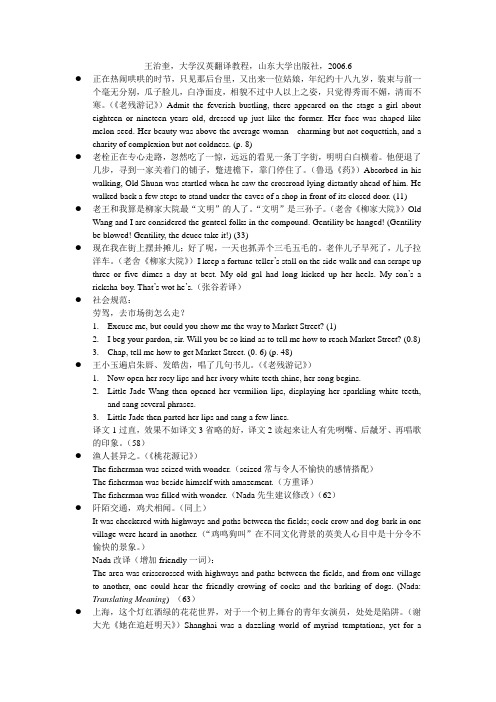
王治奎,大学汉英翻译教程,山东大学出版社,2006.6●正在热闹哄哄的时节,只见那后台里,又出来一位姑娘,年纪约十八九岁,装束与前一个毫无分别,瓜子脸儿,白净面皮,相貌不过中人以上之姿,只觉得秀而不媚,清而不寒。
(《老残游记》)Admit the feverish bustling, there appeared on the stage a girl about eighteen or nineteen years old, dressed up just like the former. Her face was shaped like melon-seed. Her beauty was above the average woman---charming but not coquettish, and a charity of complexion but not coldness. (p. 8)●老栓正在专心走路,忽然吃了一惊,远远的看见一条丁字街,明明白白横着。
他便退了几步,寻到一家关着门的铺子,蹩进檐下,靠门停住了。
(鲁迅《药》)Absorbed in his walking, Old Shuan was startled when he saw the crossroad lying distantly ahead of him. He walked back a few steps to stand under the eaves of a shop in front of its closed door. (11)●老王和我算是柳家大院最“文明”的人了。
“文明”是三孙子。
(老舍《柳家大院》)OldWang and I are considered the genteel folks in the compound. Gentility be hanged! (Gentility be blowed! Gentility, the deuce take it!) (33)●现在我在街上摆卦摊儿;好了呢,一天也抓弄个三毛五毛的。
王治奎《大学英汉翻译教程》【笔记课后习题及翻译示例汇总考研真题详解】(重在交际)

第6章重在交际6.1 复习笔记一、转换(一) 词类转换由于汉语中的动词使用频率大大高于英语,因此英汉翻译中,常把名词、介词等转换成动词。
1. 英语名词转译成汉语动词The growing awareness by millions of Africans of their extremely poor and backward living conditions has prompted them to take resolute measures and create new ones.[译文]数以百万计的非洲人已逐渐意识到他们的生活状况异常贫穷落后,这就促使他们奋起采取坚决措施去创造新的生活条件。
[分析]译文中将名词awareness译为动词,同时将形容词growing转换为相应的副词,其他部分也作相应变化,符合汉语表达习惯,译文通顺流畅。
此外,将名词派生的动词和名词转用的动词转译成名词的情况,也时有发生。
例:The novel satirizes the marriage of convenience.这部小说是对建立在利害关系基础上的婚姻的讽刺。
2. 英语介词和副词转译成汉语动词With unemployment high, the dollar low and the stock market in distress, theeconomy will be the President’s sternest trial.失业增多,美元贬值,股票市场不景气,经济问题将成为总统面临的最严峻的考验。
(二) 语态转换1. 英语被动句常常译成汉语主动句。
A truly elegant taste is generally accompanied with excellency of heart. (Henry Fielding)真正的审美力与心灵美通常是不可分的。
2. 英语被动句译成汉语时,仍保留原来的被动形式。
王治奎《大学英汉翻译教程》【笔记课后习题翻译示例汇总】-第12~14章【圣才出品】
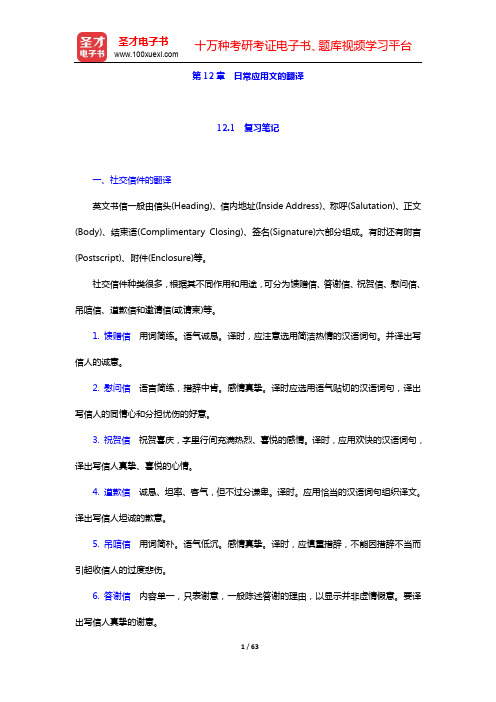
第12章日常应用文的翻译12.1 复习笔记一、社交信件的翻译英文书信一般由信头(Heading)、信内地址(Inside Address)、称呼(Salutation)、正文(Body)、结束语(Complimentary Closing)、签名(Signature)六部分组成。
有时还有附言(Postscript)、附件(Enclosure)等。
社交信件种类很多,根据其不同作用和用途,可分为馈赠信、答谢信、祝贺信、慰问信、吊唁信、道歉信和邀请信(或请柬)等。
1. 馈赠信用词简练。
语气诚恳。
译时,应注意选用简洁热情的汉语词句。
并译出写信人的诚意。
2. 慰问信语言简练,措辞中肯。
感情真挚。
译时应选用语气贴切的汉语词句,译出写信人的同情心和分担忧伤的好意。
3. 祝贺信祝贺喜庆,字里行间充满热烈、喜悦的感情。
译时,应用欢快的汉语词句,译出写信人真挚、喜悦的心情。
4. 道歉信诚恳、坦率、客气,但不过分谦卑。
译时。
应用恰当的汉语词句组织译文。
译出写信人坦诚的歉意。
5. 吊唁信用词简朴。
语气低沉。
感情真挚。
译时,应慎重措辞,不能因措辞不当而引起收信人的过度悲伤。
6. 答谢信内容单一,只表谢意,一般陈述答谢的理由,以显示并非虚情假意。
要译出写信人真挚的谢意。
7.翻译正式请柬应选用庄重、严谨的汉语词句组织译文,可套用汉语传统的请柬习语与程式。
例:为欢迎马塔·兰小姐,罗杰·B·克拉克博士及夫人,谨定于9月20日(星期四)8时于派克大街250号举行宴会,敬请弗兰克·诺斯先生及夫人光临。
回柬一般按收到的请柬格式行文,可参照请柬的翻译要求处理。
二、事务应用文的翻译(一) 事务书信事务信件措辞更严谨,语气更庄重。
翻译事务性书信,可适当套用汉语相应书信和公函的常用习语,表达原文的意思。
1. 推荐信推荐信是向个人或单位推荐某个自己熟悉的入而写的信件,一般措辞精练、语气中肯、叙事客观。
写给单位的推荐信,其称呼常用“To Whom It May Concern”,意思是“致有关人士”,可套用汉语书函用语,将其译成“敬启者”或“台鉴”等。
- 1、下载文档前请自行甄别文档内容的完整性,平台不提供额外的编辑、内容补充、找答案等附加服务。
- 2、"仅部分预览"的文档,不可在线预览部分如存在完整性等问题,可反馈申请退款(可完整预览的文档不适用该条件!)。
- 3、如文档侵犯您的权益,请联系客服反馈,我们会尽快为您处理(人工客服工作时间:9:00-18:30)。
第18章文学翻译18.1 复习笔记一、文学翻译的标准对于文学翻译的要求是,“用另一种语言,把原作的艺术意境传达出来,使读者在读译文的时候能够像读原作时一样得到启发、感动和美的感受”。
钱钟书把文学翻译的最高标准概括为一个“化”字。
二、文学翻译的过程借鉴茅盾的有关解释,把文学翻译过程分为三个阶段:(1) 理解阶段;(2) 印证阶段;(3) 表达阶段。
在表达阶段强调的内容是:(1) 必须使用文学语言;(2) 尽量保持原作风格;(3) 力求内容和形式的辩证统一。
三、文学翻译须使用文学语言这里仅介绍英文小说翻译的几个侧面:1. 文学语言具有准确、形象、生动、自然等特征,译者应根据原作的艺术意境和语言特色,在译文里寻找适当的语言形式,使之文情并茂。
Daffodils all along the hedgerow swung like yellow, ruffled birds on their perches.清风徐徐,沿灌木篱笆旁的水仙花轻轻地摇摆着,颇似栖息的鸟儿掀动着金黄色羽毛。
2. 运用娴熟的汉语,再现人物语言的形象化和个性化,使译文产生“如闻其声,如见其人”的艺术效果。
“Say, some tenderness, that!” This is reference to a smile or a melting glance on the part of a female.“唷,瞧那样多温存!”这说的是一位女性的嫣然一笑,或者回眸传情。
3. 凭借自己的审美体验,深刻理解原作的艺术美,进而形神兼备地再现这种艺术美。
四、加强文学翻译的基本功训练有兴趣于或有志于从事文学翻译的青年,可在课内外分门别类地选做一些练习,以集中提高某些方面的表述能力。
18.2 课后习题详解将下列英文译成汉语:1. One morning, in the fall of 1880, a middle-aged woman, accompanied by a young girl of inquiry as to whether there was anything a- bout the place that she could do. She was of a helpless, fleshy build, with a frank, open countenance andan innocent, diffident manner. Her eyes were large and patient, and in them dwelt such a shadow of distress as only those who have looked sympathetically into the countenances of the distraught and helpless poor know anything about. Any one could see where the daughter behind her got the timidity and shamefacedness which now caused her to stand back and look indifferently away. She was a product of the fancy, the feeling, the innate affection of the untutored but poetic mind of her mother combined with the gravity and poise which were characteristic of her father. Poverty was driving them. Together they presented so appealing a picture of honest necessity that even the clerk was affected. (Theodore Dreiser: Jennie Gerhardt, 1911)【答案】1880年秋天的一个早晨,有一个中年妇人,带着一个18岁的青年女子,走进俄亥俄州科伦坡市的大旅馆里,到账房的写字台前,问他旅馆里有没有她能做的活。
那妇人生着副绵软多肉的体格,一张坦率开诚的面容,一种天真羞怯的神气。
一双大落落的柔顺眼睛,里边隐藏着无穷的心事,只有那些对于凄惶无告的穷苦人面目作过同情观察的人才看得出来。
跟在她后面的是她的女儿,一种畏惧和羞怯使她躲缩在后边,眼睛不敢对面前正视,这种神情是谁都看得出她从哪儿得来的。
原来她的母亲虽然没有受过教育,却有一种含有诗意的心情,具备着幻想、感情和天生的仁厚,她的父亲呢,又特具一种沉着和稳重的性格,两下结合起来造成她这样一个人了。
如今贫穷正在逼迫她们。
当时她母女俩那种穷困窘迫的情景是很动人的,连那账房也受感动了。
(傅东华译:《珍妮姑娘》,1959) 2. My mother chose to understand her (Peggy) in terms of another religion. “Isuppose,” she said, “only God really gives. But people can give by not denying, which comes to the same thing.” And then, like a stream swirling past a snag, the flow of her talk resumed, and her memories of buying the farm broadened to the farm itself, as it had been at the moment of purchase ravaged, eroded as it had been in her girlhood, the big upper field an ocean of barley, the little flat upper field laid out in tomato rows, the triangular field across from the meadow golden-green with sweet corn, the far field silver-green with alfalfa, a truck garden of potatoes and onions and cabbages and staked peas stretched all along the sandy ridge beyond the orchard whose overburdened lower limbs wore crutches, and even the woods fruitful, of berries and hickory nuts and firew0od;the farm as it was now, at rest, the shaggy fields needing to be mowed. (John Updike: Of the Farm, 1965)【答案】我母亲有意从另一种信仰理解她(佩吉)。
“我认为,”她说,“只有上帝才算真正地赐予。
但是人能通过不拒绝来实现给予,可谓殊途同归吧。
”犹如小溪绕过暗礁一样,她的谈话又滔滔不绝起来。
她的记忆从购买农场扩展到了农场本身:当时是一片荒芜的、水土侵蚀严重的不毛之地。
当她进入少女时期时,那一大片上坡地已经化作大麦的海洋;那一小片平坦的上坡地栽满了一排排、一行行的西红柿;草地对过的三角地里,甜玉米绿里透黄;远处的田野里,苜蓿绿中泛白;果园里那边沙岭一带的菜园中,有土豆、洋葱、大头菜,还有用木桩架起的豌豆;这边果园里,被果实压低的树枝用木棒支撑着;甚至树林里,除随处可见的烧柴木之外,浆果和山核桃都仰首皆是;而眼下的农场已闲置荒芜,杂草丛生,亟待耕锄。
(王治奎泽:《农场省亲》)3. Narcissus is said to have been a young man of wonderful beauty, but intolerably proud, fastidious, and disdainful. Pleased with himself and despising all others, he led a solitary life in the woods and hunting grounds; with a few companions to whom he was all in all; followed also wherever he went by a nymph call Echo. Living thus, he came by chance one day to a clear fountain, and (being in the heat of noon) lay down by it; when beholding in the water his own image, he fell into such a study and then into such a rapturous admiration of himself, that he could not be drawn away from gazing at the shadowy picture, but remained rooted to the spot till sense left him; and at last he was changed into the flower that bears his name; a flower which appears in the early spring; and is sacred to the infernal deities,--Pluto, Proserpine, and the Furies. (Sir Francis Bacon: Narcissus; or Self-Love)【答案】那喀索斯,人称风度翩翩美少年,惟心性高傲,锱铢必较,蔑视一切,令人不堪。
自我陶醉,目无余子,常年出没于林泉猎场,优游岁月,与世人不相往来;有俦侣二三,如鱼得水;行踪所至,仙女跬步不离,芳名厄科。
朝夕如此,一日偶至清泉一泓,时值晌午,天气炎热,遂卧躺泉边,俯观水中倒影,始而不觉凝神观照继而自我恋慕,如痴如狂,谛视自家面貌若隐若现,良久不去,出神入定,有如树木扎根,直至感觉消失;终于变作水仙,名日那喀索斯;水仙早春开花;遂为冥府诸神之祭品——普路托,普罗塞耳皮娜,复仇三女神。
